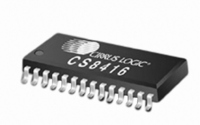CS8416-CNZ Cirrus Logic Inc, CS8416-CNZ Datasheet - Page 31

CS8416-CNZ
Manufacturer Part Number
CS8416-CNZ
Description
IC RCVR DGTL 192KHZ 28QFN COMM
Manufacturer
Cirrus Logic Inc
Type
Digital Audio Interface Receiverr
Datasheet
1.CS8416-CZZ.pdf
(60 pages)
Specifications of CS8416-CNZ
Applications
Digital Audio
Mounting Type
Surface Mount
Package / Case
28-QFN
Audio Control Type
Digital
Control Interface
I2C, SPI
Control / Process Application
AV & DVD Receivers, CD-R, Digital Mixing Consoles
Supply Voltage Range
3.13V To 5.25V, 3.13V To 3.46V
Lead Free Status / RoHS Status
Lead free / RoHS Compliant
For Use With
598-1017 - BOARD EVAL FOR CS8416 RCVR
Lead Free Status / RoHS Status
Lead free / RoHS Compliant, Lead free / RoHS Compliant
Other names
598-1723
DS578F3
10.2
10.2.1 Format Detection
10.3
Non-Audio Detection
An AES3 data stream may be used to convey non-audio data, thus it is important to know whether the in-
coming AES3 data stream is digital audio or not. This information is typically conveyed in channel status bit
1, which is extracted automatically by the CS8416. However, certain non-audio sources, such as AC-3™ or
MPEG encoders, may not adhere to this convention, and the bit may not be properly set. The CS8416 AES3
receiver can detect such non-audio data through the use of an autodetect module. The autodetect module
is similar to autodetect software used in Cirrus Logic DSPs.
If the AES3 stream contains sync codes in the proper format for IEC61937 or DTS
internal AUTODETECT signal will be asserted. If the sync codes no longer appear after a certain amount
of time, autodetection will time-out and AUTODETECT will be de-asserted until another format is detected.
The AUDIO signal is the logical OR of AUTODETECT and the received channel status bit 1 (as decoded
according to the CHS bit in the Control1 register).
In Hardware Mode, AUDIO is output on pin 15. In Software Mode, AUDIO is available through the GPO pins.
If non-audio data is detected, the data is still processed exactly as if it were normal audio. The exception is
the use of de-emphasis auto-select feature which will bypass the de-emphasis filter if the input stream is
detected to be non-audio. It is up to the user to mute the outputs as required.
Interrupts
The CS8416 has a comprehensive interrupt capability. The INT signal, available in Software Mode, indi-
cates when an interrupt condition has occurred and may be output on one of the GPOs. It can also be set
through bits INT[1:0] in the Control1 register (01h) to be active low, active high or active low with no active
pull-up transistor. This last mode is used for active low, wired-OR hook- ups, with multiple peripherals con-
nected to the microcontroller interrupt input pin.
Many conditions can cause an interrupt, as listed in the interrupt status register descriptions. Each source
may be masked off through mask register bits. In addition, each source may be set to rising edge, falling
edge, or level sensitive. Combined with the option of level sensitive or edge sensitive modes within the mi-
crocontroller, many different configurations are possible, depending on the needs of the equipment design-
er. Refer to the register descriptions for the Interrupt Mask (07h), Interrupt Mode MSB (08h), Interrupt Mode
LSB (09h), and Interrupt 1 Status (0Dh) registers
In Software Mode, the CS8416 can automatically detect various serial audio input formats. The Format
Detect Status register (0Bh) is used to indicate a detected format. The register will indicate if uncom-
pressed PCM data, IEC61937 data, DTS_LD data, DTS_CD data, or digital silence was detected. Addi-
tionally, the IEC61937 Pc/Pd burst preambles are available in registers 23h-26h. See the register
descriptions for more information.
®
data transmission, an
CS8416
31
















